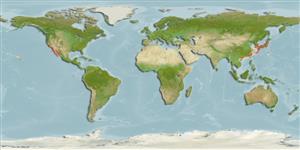Common names from other countries
Environment: milieu / climate zone / depth range / distribution range
Ecologia
marino demersale; distribuzione batimetrica 5 - 46 m (Ref. 2850). Subtropical; 41°N - 16°N
Eastern Pacific: Humboldt Bay in California, USA to Mexico. Northwest Pacific: Japan (Ref. 559).
Size / Peso / Age
Maturity: Lm ? range ? - ? cm
Max length : 250 cm TL maschio/sesso non determinato; (Ref. 40637); peso massimo pubblicato: 255.6 kg (Ref. 4699); Età massima riportata: 75 anni (Ref. 4563)
Occur on rock bottoms; near shore, outside kelp beds and along drop-offs (Ref. 2850). Large specimens usually found deeper than 30 m, small ones over sand and in kelp beds mostly from 12-21 m (Ref. 2850). Aggregate for spawning in summer (Ref. 2850). Pelagic spawners (Ref. 56049). Longevity of 90 to 100 years (Ref. 56049) stemmed from speculation on the age of a 557 lb fish caught in 1962, but the oldest age determined from otoliths of a 435 lb fish was 72 to75 years (Ref. 4563). Validated age so far is up to >50 years using bomb radiocarbon (A.H. Andrews, pers. comm.)
Pelagic spawner (Ref. 56049).
Eschmeyer, W.N., E.S. Herald and H. Hammann, 1983. A field guide to Pacific coast fishes of North America. Boston (MA, USA): Houghton Mifflin Company. xii+336 p. (Ref. 2850)
IUCN Red List Status (Ref. 130435)
CITES (Ref. 128078)
Not Evaluated
Threat to humans
Harmless
Human uses
Pesca: commerciale; Pesce da pesca sportiva: si
Strumenti
Special reports
Download XML
Fonti Internet
Estimates based on models
Preferred temperature (Ref.
115969): 14.8 - 23, mean 20.9 (based on 48 cells).
Phylogenetic diversity index (Ref.
82804): PD
50 = 0.8125 [Uniqueness, from 0.5 = low to 2.0 = high].
Bayesian length-weight: a=0.01122 (0.00514 - 0.02450), b=3.04 (2.87 - 3.21), in cm Total Length, based on all LWR estimates for this body shape (Ref.
93245).
Trophic level (Ref.
69278): 4.5 ±0.80 se; based on food items.
Resilienza (Ref.
120179): Molto basso, tempo minimo di raddoppiamento della popolazione più di 14 anni (tm=11; tmax=75; also Musick et al. 2000 (Ref.
36717)).
Fishing Vulnerability (Ref.
59153): Very high vulnerability (86 of 100).
Climate Vulnerability (Ref.
125649): High vulnerability (63 of 100).
